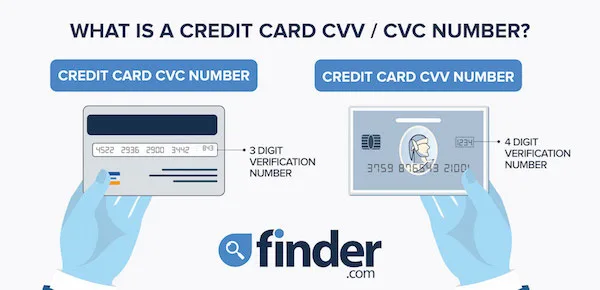
What is a CVV or CVC number?
If you’re using your credit card to make a purchase online or over the phone, you’ll usually be asked to provide the name on your card, the account number, expiry date and something called your CVV, CVC or security number or code.
Your CVV number (card verification value) or CVC (card verification code) on your credit card or debit card is a three- or four-digit number printed on your card. If you have a Visa or Mastercard credit or debit card, it’ll be a three-digit number on the back of your card. If you’re using an American Express card, the CVV will be a four-digit number on the front of your card.
The CVV is an anti-fraud measure that’s used when you make a purchase that doesn’t require you to enter a PIN or sign a receipt. This is why you’re often asked to enter your CVV number if you’re shopping online or making a purchase over the phone, as it lets the merchant or payee verify that you have the physical card and are indeed the cardholder.
As the CVV or CVC number is printed only on your card, it’s important that you keep your card safe and secure. If your card is lost or stolen, anyone could use the card to make purchases online or over the phone without your permission. If this does happen, contact your card issuer immediately to cancel the card and keep an eye on your statement to report any fraudulent transactions. The CVV or CVC number is called a Secure Socket Layer (SSL) – commonly used technology which is a digitally provided certification process.
Is a CVV or CVC number called anything else?
The credit card CVC and credit card CVV numbers are sometimes called different things depending on the credit card network or credit card company that issued it. For example, Mastercard calls the code CVC2, American Express refers to it as CID, and Visa has dubbed it CVV2, while other providers may refer to a CSC (card security code).
Despite these different names, the codes all serve the same function and are used as a standardised security measure. In the case of contactless cards there is generally a chip involved which supplies its own electronically generated series of codes. They are called “Dynamic CVV” or iCVV.
Are CVV or CVC numbers the same as my PIN?
No, your CVV or CVC number is different from the PIN code you use to make cash machine withdrawals or in-store debit or credit card transactions. Your CVC or CVV number is used for verifying online or over the phone payments when you can’t use your PIN or signature.
While the CVV or CVC number is in place to protect your credit card from fraudulent transactions, it could still be used fraudulently if you don’t use a secure site. If you spot a transaction you don’t recognise on your statement, contact your bank immediately to report the issue and protect your finances.
More guides on Finder
-
Groceries, Netflix, takeaways: The best everyday purchases to rack up points
Discover how to supercharge your points through everyday spending – plus a few ways to redeem them with the American Express® Preferred Rewards Gold Credit Card. (Paid content)
-
Finder Credit Cards Customer Satisfaction Awards 2025
The results of our 2025 Finder Credit Card Customers Satisfaction Awards are in! Find out the winner and most recommended providers.
-
Best credit cards to use abroad in 2025
Pick a card with 0% foreign fees and save big. We’ve rated 20+ cards for spending abroad and listed our top 5.
-
What is the average credit card APR in the UK?
We look at the average APR on credit cards in the UK and how credit card interest rates have changed over time.
-
ASOS credit card (in partnership with Capital One) review
ASOS has launched its own credit card, but how does it weigh up against the market?
-
What’s Monzo Flex and should you get your hands on one?
Find out how to spread your purchases over 3, 6 or 12 months with Monzo Flex.
-
Credit card statistics and trends UK
We look at the latest statistics on credit card ownership and spending in the UK. Here’s what we found.
-
Methodology for rating credit cards
Get all the details on how we rate the credit cards we review. We look at costs, fees, features and how well a card performs compared to the rest of the market.
-
Where do Brits go on holiday?: Popular travel destinations
Where do UK residents go on holiday and how many overseas visits do we take? We look at the latest outbound tourism statistics.
-
Compare 0% purchase credit cards
Buy now and pay interest later with a 0% purchase credit card. Compare current offers with 0% p.a. on purchases.